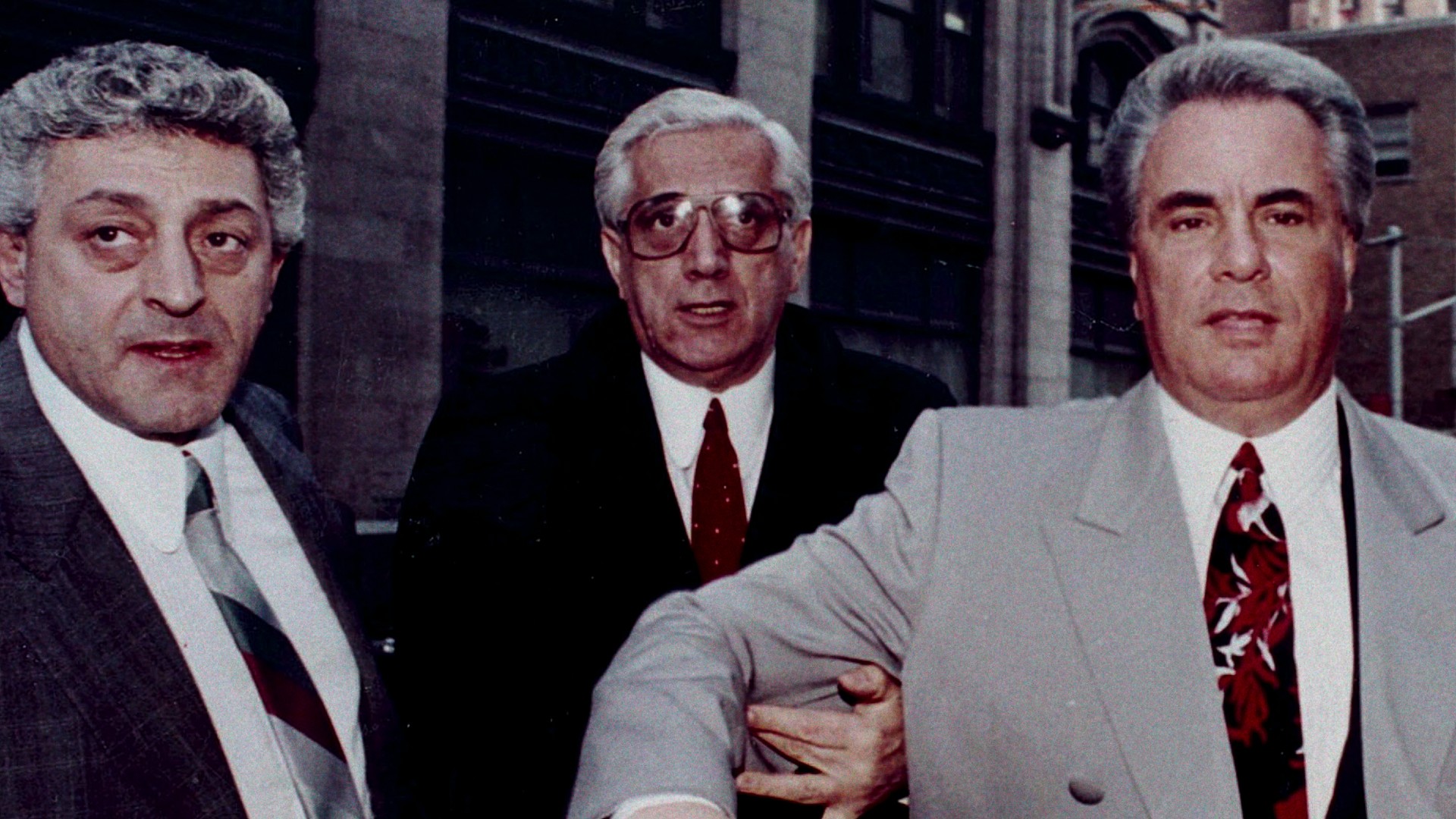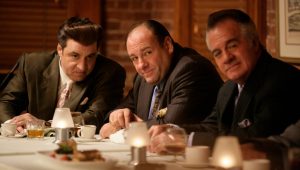
This article contains spoilers for Get Gotti.
Netflix’s Get Gotti puts the spotlight on a New York gangster icon, whose camera-ready presence signaled his downfall. The prosecutorial team sees John Gotti as an affront to decency. The capos, soldiers, and neighborhood acquaintances see only a larger-than-life street savior, with the balls and brains to make something of the communities he oversees.
The FBI and New York’s Organized Crime Task Force (OCTF) couldn’t get their heads around it. Everyone on Carmine Street had no doubt the feds were itching to nail John Gott to a high-voltage crucifix so they could display him like a Christmas tree ornament. But the real sins committed are those against the organization Gotti headed. The Teflon Don broke more mafia edicts than federal crimes. That put him in the spotlight, a place where it’s easy to mistake exposure for protection.
For as thorough as Get Gotti is, you’re bound to leave the three episode docuseries with some questions. Thankfully we’ve got the answers! Answers to questions like …
NOTE: The main source for this article comes from Netflix’s Get Gotti, but additional sources include The Mafia, by Al Cimino, Jo Durden Smith, M. A. Frasca; Gotti: Rise and Fall, by Jerry Capeci and Gene Mustain; This Family of Mine: What It Was Like Growing Up Gotti, Victoria Gotti; The Valachi Papers, by Peter Maas, Wiseguy, Nicholas Pileggi; Family Dynasty, John H. Davis; The New York Daily News, April 13, 1986; The New York Times June 18, 2002.
What Were Gotti’s Family Connections?
Get Gotti, like most documentaries on John Gotti, begins with the execution of Gambino Crime Family boss, Paul Castellano. The man who would take his place did not magically materialize in that position, parked up the block from Sparks Steak House on Dec. 16, 1985. Gotti had a past. Born in the Bronx on Oct. 27, 1940, John was the fifth of the 13 children, two of whom died at birth. His parents, a wandering laborer named John Joseph Gotti Sr., and Philomena DeCarlo, who the family called Fanny, were born in New York City, but their people came from San Giuseppe Vesuviano, in Naples, Italy, not Sicily.
The Gotti family moved to East New York, Brooklyn, when John was 12, and he got in with the Fulton-Rockaway Boys gang. Membership was a stepping stone to the local mob scene. John tried to steal a cement mixer from a construction site when he was 14, and got injured giving him a noticeable life-long limp. Gotti attended Franklin K. Lane High School, but dropped out when he was 16.
Gotti married Victoria DiGiorgio on March 6, 1962. She had a child from a previous marriage, to which they added five children: Angela, Victoria, John Jr., Frank and Peter. Gotti worked as an assistant truck driver, and a presser in a coat factory, but couldn’t resist the extra money to be had in the other life. Gotti was not born immune to conviction. He did two jail stints by 1966.
Gotti, his brother Gene, and a childhood friend were arrested in 1968 for stealing Northwest Airlines cargo from a truck hijacked at JFK airport. All three pleaded guilty, John was sentenced to a three-year term, and released in 1971. In 1973, Gotti earned his button, committing his first murder. He was given the venerated task of shooting Jimmy McBratney, who kidnapped and murdered Carlo Gambino’s nephew. Gotti was apprehended in 1974, and handed a for-year sentence. He was released after serving half his time, and when he got out of jail, Gotti became an initiated, burning-card-holding member of the Mafia Family.
Gotti also had a tight-knit family at home, kept close in all aspects of life and work. His brothers, Eugene “Gene” Gotti and Peter Gotti, were made men. Richard V. Gotti moved up to the rank of caporegime by 2002, the same year Vincent Gotti promised his life to this thing of theirs. John Gotti Jr. was made acting boss of the Gambino Family during Gotti’s incarceration, though he ran operations from his jail cell, and after the don’s death.
What Happened to Frank Gotti?
John Gotti’s 12-year-old son, Frank, was riding a motorized mini-bike around the block on Howard Beach in Queens on March 18, 1980. As he rode past a home on 157th Avenue, where a construction dumpster created a blind spot for oncoming traffic, a speeding car driven by a drunk John Favara struck Frank’s bike. Unaware he had killed somebody, Favara dragged the child 200 feet before realizing Frank was trapped under his wheels.
Young Frank loved sports, was slated for his school’s football team, and did not know about father’s business. Favara did, but did not take the death threats he received seriously. Favara’s car disappeared on April 13, 1980. Frank Gotti’s funeral service sent him a card on May 1, 1980. When Favara’s car was found, the word “murderer” was painted on it. Gotti’s wife Victoria attacked Favara with a baseball bat. Favara was abducted while leaving work on July 28, 1980. It was the last time he was ever seen. He was declared dead three years later, in 1983, when authorities still could not find his body. The Gotti family continues posting religious memorials to the son in an eternal mourning.
Was Gotti Really a New York Celebrity?
Gotti: Rise and Fall, by Jerry Capeci and Gene Mustain, opens with a prologue written by John Gotti. “People loved me,” he writes. “I coulda been fuckin’ president if I wasn’t having so much fun doin’ what I was doin’. You think I’m kidding’? What’s that Bill Clinton got? A 43-approval ratin’ in the polls? Stop any two people in the fucking’ street, one of ‘em would like me. That puts me seven points ahead right there.”
Gotti was not wrong. Anyone from the neighborhood had nothing but good things to say about the man. The documentary series points out how free turkeys were delivered, and this writer can attest to the Ozone Park block parties, their zeppolis, sausage-and-pepper heroes, and the famous, though some might say infamous, fireworks. This kind of local heroics puts Gotti in the same category as another Naples descendant, Al Capone, who also lived big. The Prohibition mobster gave out turkeys, organized food banks and threw parties. He played the mandolin and the banjo. Both mob bosses gave back to the community and let everyone know it.
The documentary series says Gotti had one of the best PR firms working for him, and the press played along. During Gotti’s March 1986 assault trial, complainant Romual Riekcyk testified he forgot what his attacker looked like. The New York Daily News ran the headline “I FORGOTTI,” according to The Mafia, by Al Cimino, Jo Durden Smith, M. A. Frasca. Once attorney Bruce Cutler made a consistent habit of brutalizing the prosecution, Gotti was rechristened the “Teflon Don.” Take that to the streets.
“Many mob guys have little nicknames because of something they’ve done or something they do,” Sal “Ubatz” Polisi says in Get Gotti. From its inception, major mobsters sported colorful aliases: Al “Scarface” Capone, Jack “Legs” Diamond, Meyer “The Mob’s Accountant” Lansky, Albert “Lord High Executioner” Anastasia, Frank “The Prime Minister” Costello. The titular head of the family Gotti would run was called Carlo “The Godfather” Gambino. The man he replaced in 1985 answered to “Big Paul” Castellano.
When Gotti first hit the tabloids, he was dubbed the “Dapper Don,” because he maintained a cultivated style, like $2,000 double-breasted Brioni suits with hand-painted ties and coordinated pocket squares. The New York Times reported the immaculate multiple-defendant had a daily beauty regimen as clean as his federal conviction record: a professional manicure, haircut, and blow-dry. The boss expected the same from his capos and crew. God forbid a tie clashed with a shirt, Gotti could be murderous in fashion criticisms. But this is also a gangster tradition. The great Arnold “The Brain” Rothstein schooled Charles “Lucky” Luciano’s precociously ferocious crew on style, substance, and taste in the late 1910s. The young mobsters went to the hottest clubs in the swankiest duds.
Celebrities and gangsters have hung out together since the days of Prohibition, when actor George Raft danced at night and drove mob boss Owney Madden around until morning. Organized crime created the modern entertainment industry, and was enjoyed by entertainers. They shared illegal booze, performance space, customers, and the occasional mouthpiece for crimes which were made to disappear from official history.
It is possible Gotti would have been a celebrity regardless of what line of work he got into. In her book, This Family of Mine: What It Was Like Growing Up Gotti, Victoria Gotti says her grandfather, John’s journeyman father, got very friendly with Tony Curtis and had a flirtation with Jane Russell while working out west as a camera grip. The high-rolling Gambino boss’s celebrity friends came by to show support during the racketeering trials, like John Amos, who was escorted by a Gotti associate, as well as Mickey Rourke and Jay Black of Jay and the Americans, who went on Gotti family passes.
Gotti was a celebrity, made the cover of Time magazine, and threw star-studded parties after federal acquittals. “Andy Warhol was blowing coke with us,” former associate Anthony Ruggiero Jr., enthuses in Get Gotti. “David Bowie was blowing coke with us. They knew we wouldn’t call the magazines, and we had good coke.”
Were Drugs Really Off Limits to the Mob?
As Get Gotti points out, Gotti’s upward mobility under Castellano hit a major roadblock because of drug dealing associates. It’s a long-standing belief the Mafia traditionally avoids drugs, and paid a price for staying out of the market. The mob war in The Godfather begins when Vito Corleone (Marlin Brando) turns down an offer to finance Virgil “The Turk” Sollozzo’s (Al Lettieri) heroin operations, even though it comes with a guarantee against his investment from the Tattaglia Family. The film and novel’s commission sees it as stopping progress and profit.
At the commission meeting, Don Zaluchi (Louis Guss) admits: “For years I paid my people extra so they wouldn’t do that kind of business. Somebody comes to them and says, ‘I have powders; if you put up three, four-thousand-dollar investment, we can make fifty thousand distributing.’ So, they can’t resist.” Even Sonny Corleone (James Caan, who attended Gotti events as a close friend) says “there’s a lot of money in that white powder.”
Vito Corleone warns the ruling commission “this drug business is going to destroy us in the years to come. Even the police departments that have helped us in the past with gambling and other things are gonna refuse to help us when it comes to narcotics.”
Although it is ultimately decided that drug trafficking would be controlled as a business, this warning was prescient and specific. It came true with extreme prejudice: RICO laws, drug sentencing, and plea bargains. Overnight, anyone caught dealing dope had incentive to flip. In Peter Maas’ 1968 book The Valachi Papers, capos told crews not to fool around with “junk.” Because of incommensurate drug sentencing, a small-time associate could ultimately bring down a mafia father. Because of a drug bust, low-level soldier Joe Valachi, doing time in Atlanta Federal Pen, was put in a position to rat out his superiors, a death sentence itself from the mob. His testimony got family head Vito Genovese imprisoned on drug charges in 1959. These were terrible precedents. Valachi compounded his crimes against crime, breaking omerta, the code of silence, as loud as he could and to anyone who would listen.
Valachi named the organization that should not be named, telling a Senate subcommittee in 1963 that the syndicate called itself “Cosa Nostra,” or “Our Thing.” According to FBI documents, New York family heads Paul Castellano and Vincent “the Chin” Gigante, and Philadelphia’s Angelo Bruno banned narcotic sales because of the tremendous legal jeopardy on drug sentencing which was pushed in the early 1970s.
In 1980, Henry Hill, the central character of Martin Scorsese’s Goodfellas, played by Ray Liotta, was arrested for drug trafficking. He flipped on the Lucchese Family, and gave evidence that led to 50 convictions, according to Nicholas Pileggi’s book Wiseguy. In 1993, Gravano – Gotti’s own underboss – confirmed the mafia’s “policy was against drugs” in sworn testimony. He turned government witness because of a drug bust which carried heavy sentencing. This was the very reason behind the edict. Although, to be fair, the message was usually more loosely uncoded to mean: Don’t sell drugs, but if you do, the bosses want their cut, as we hear in Get Gotti.
The truth is drugs have been on the mob’s shelf since the days of commission founder Charles Luciano. Later, as a deportee, he helped broker “The French Connection,” which brought opium from the East to Corsica or Southern France for refinement, and smuggled into the U.S. Because of his coke habit, Capone had to dry out before settling into federal prison. Joe Gallo was isolated and watched for 24 hours to be sure he didn’t go through withdrawal before he was initiated into the mafia. Besides, the Bonanno family controlled the major narcotics turf. But they were not alone.
The Lucchese and Colombo families partnered with Harlem’s “Nicky” Barnes for a long-running heroin trafficking operation, lucrative for both sides. Connected guys partnered with the Pagans motorcycle gang for methamphetamine deals. The Sicilian Mafia’s “Pizza Connection” brought about $1.6 billion in heroin into the east coast between 1975 and 1984 before being better known as one of the biggest busts in New York City history.
How Big Was the Gambino Crime Family?
When Gotti moved to take over the Gambino Family, they had more than 300 made members, and 2,000 associates who infiltrated all aspects of construction, the garment district, garbage and waste management and hauling, and still made money in traditional trades like extortion, union control, and loan sharking. They all kicked up to Gotti, who reportedly could pull in millions in a year when things were especially smooth.
The Gambino Crime Family was the largest and most influential of the Five Families in New York City. It was also one of the most recognizable criminal organizations in America. It was founded by Palermo, Sicily mobsters Ignazio Lupo and Giuseppe Morello, claimed as the Salvatore “Toto” D’Aquila gang in 1910, and became a family after the Castellammarese War of 1931 under Vincent Mangano who transformed it into one of the biggest criminal organizations in the world.
Albert Anastasia, best known for overseeing the Brooklyn waterfront and Murder Incorporated, was underboss. Mangano disappeared in 1951. Anastasia took control, and ordered hundreds of assassinations in a paranoid power move. Anastasia was executed on a barber chair at the Park Sheraton Hotel in Manhattan in 1957. Carlo Gambino, who took over, was one of the most successful crime bosses of all time. He strengthened operations, increased profit, and remained out of the public eye. He was never linked to criminal activity, and ran the family until 1976 without spending a single day in jail. He died on Oct. 15, 1976, of a heart attack. His successor’s cause of death is only considered natural in the world of organized crime.
Was Paul Castellano a Bad Boss?
The organization passed to Gambino’s brother-in-law Paul Castellano, who split the family’s take between white collar crimes like stock deals and embezzlement, which he managed, and traditional Cosa Nostra evergreen moneymakers, like loan sharking, robberies, gambling, labor-union racketeering, and international heroin smuggling, which he gave over to consigliere, Aniello Dellacroce, the former underboss who had been passed over for leadership.
The Borgata did very well under Castellano for a full decade. The Gambino Family made money; enjoyed expert leadership; were one of the two most dominant criminal forces in New York and New Jersey; and expanded into Connecticut, Baltimore, South Florida, California, and Sicily. Some members were dissatisfied, thinking Castellano acted more like a business owner than a Don.
Like Michael Corleone in The Godfather, Part II, the new boss filling the old Godfather’s shoes had an eye toward legitimate business, which carried less risk, and promised larger payoffs. Distancing the organization from its most dangerous operation, Castellano put a ban on drug trafficking. This was the rank and file’s bread and butter, and the boss was deemed toast. Two weeks after the cancer death of Dellacroce in 1985, Castellano was murdered, along with his underboss Thomas Bilotti. The execution might have been a pre-emptive strike. It certainly sets off a firestorm of activity. There was a new Godfather in town, and he looked the part.
How Did John Gotti Get Caught?
For the FBI and the OCTF, it was love at first sight for Gotti. While he fit the profile of Castellano’s killer straight off the rack, he was custom-made for perp walks and handcuffs. Rats and secret FBI surveillance tapes brought down the Teflon Don. That, and having his attorney, the tenacious and committed ex-prosecutor Bruce Cutler, barred from his defense team in court. Additionally, the government unveiled a much larger, and more effective legal weapon. Congress passed the Racketeer Influenced and Corrupt Organizations (RICO) Act in 1970. It gave law enforcement carte blanche to “attack criminal enterprises on a broad front, stripping them of their leadership and sources of both illicit and legitimate revenue in one massive prosecution,” according to Congressional Quarterly’s 1992 filing.
Federal and State cops got a court order allowing them to install electronic eavesdropping devices, with advancements most of the agents themselves had never seen, the docuseries points out. The FBI tried to convince Gotti’s associates to flip, or turn on the boss in open court. Their other weapon was the Witness Security Program. Run by the U.S. Marshals Service since 1971, it provides endangered witnesses with a new identity, and a financial stipend to begin anew in remote parts of the country. Usually removed from the culinary delicacies to be had in the cities.
On Dec. 11, 1990, Gotti, Gravano, and Consigliere Frank Locascio were arrested during a raid on the Ravenite Social Club in Little Italy, and charged with racketeering, murder conspiracies, tax evasion, bribery, extortion, and jury tampering. The crime head walked off with a jaunt in his step. Gotti beat a 1984 assault and theft charges after a fender bender when the alleged victim refused to admit any hint of recognition on the stand. In March 1987, Gotti was acquitted of federal racketeering and conspiracy charges when his associates allegedly bribed a juror in Brooklyn. In 1990, Gotti representatives reputedly paid for an acquittal in the attempted murder of a union official. For the new trial, the judge ordered that the jurors remain anonymous, identified only by number, so no one could pressure them, and to prevent bribes.
Seated on the cold bench of a squealer’s immunity, Gravano testified for nine days on the stand in the 1992 trial. He claimed Gotti orchestrated killings to assert power, and dodge Castellano’s lethal dissuasion to drug sales. Describing his role as a backup shooter, Gravano testified to being in the car with Gotti during the Castellano and Bilotti hit. At the time, Gotti’s Underboss was the highest-ranking gang member to turn government witness. In 2004, Bonanno family boss Joseph “The Ear” Massino became the first mafia boss to squeal.
It took the jury 14 hours of deliberations before they found Gotti guilty of all 13 charges in April 1992. In June, Gotti was sentenced to life in prison without a chance of parole. Gotti went to a maximum-security prison in 1992. He was diagnosed with cancer in 1998, and had surgery to remove a tumor, but died in jail in 2002.
Get Gotti is currently streaming on Netflix.
The post Everything Netflix’s Get Gotti Leaves Out About John Gotti appeared first on Den of Geek.





